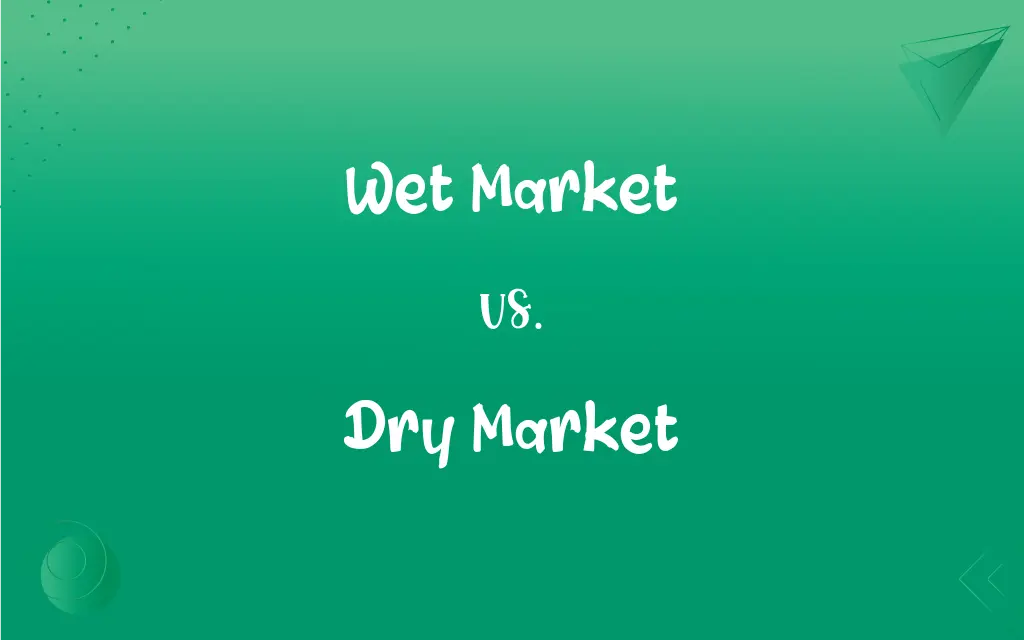Wet Market vs. Dry Market: What's the Difference?
Edited by Aimie Carlson || By Janet White || Published on January 2, 2024
A wet market typically sells fresh produce and perishable goods, often including live animals and seafood, while a dry market specializes in non-perishable items like textiles, electronics, and grains.

Key Differences
Wet markets are known for selling fresh, perishable goods such as fruits, vegetables, meat, and often live animals, in a typically open-air setting. Dry markets, in contrast, deal primarily in durable goods like clothing, electronics, and dry foodstuff like grains and nuts.
The term 'wet market' comes from the frequent washing of floors due to the presence of fresh produce and seafood, creating a wet environment. Dry markets are characterized by their sale of items that don't require refrigeration or special preservation, hence the term 'dry'.
Wet markets often play a vital role in providing fresh food in many communities, especially in Asian countries. Dry markets cater to a different segment, offering goods that are stored and sold in a non-refrigerated environment.
In wet markets, the emphasis is on the freshness and variety of food, which might include live fish or poultry. Dry markets focus on shelf-stable products, including textiles, household items, and spices.
Shopping in a wet market usually involves negotiating prices and picking from a range of fresh produce, whereas dry markets often have fixed prices for their more durable goods.
ADVERTISEMENT
Comparison Chart
Primary Goods Sold
Fresh, perishable items like seafood, meat, produce
Non-perishable items like textiles, electronics, grains
Environment
Often open-air, with wet floors from cleaning
Enclosed or open-air, with dry conditions
Preservation Needs
Requires refrigeration or immediate sale
No refrigeration needed, longer shelf life
Typical Location
Common in Asian countries, local communities
Found globally, often in urban areas
Price Negotiation
Often involves bargaining
Usually fixed prices
ADVERTISEMENT
Wet Market and Dry Market Definitions
Wet Market
A marketplace with a typically open-air, wet-floor environment.
Wet markets are common in many Asian countries.
Dry Market
A place where durable goods like clothing and electronics are sold.
You can find affordable textiles at the dry market.
Wet Market
A place where live animals are sold and slaughtered.
You can find live chickens in the wet market.
Dry Market
A market dealing primarily in shelf-stable products.
She bought all her cooking spices from the dry market.
Wet Market
A market selling fresh meat and produce.
The wet market is bustling in the morning with fresh seafood.
Dry Market
A market for items that do not require refrigeration.
Dry markets often sell household items and decorations.
Wet Market
A market with fresh food items, often involving price haggling.
Wet markets offer a variety of fresh fish and meat.
Dry Market
A marketplace often with fixed price goods.
Dry markets are great for buying non-food items without bargaining.
Wet Market
A market known for selling fresh, perishable goods.
She buys her vegetables fresh from the wet market.
Dry Market
A market specializing in non-perishable goods.
The dry market has a wide range of grains and spices.
FAQs
Why is it called a wet market?
Because of the wet floors from cleaning and selling fresh items.
What do you find in a dry market?
Non-perishable goods like clothing, electronics, and dry foodstuff.
Can you buy meat in a dry market?
No, meat is typically sold in wet markets due to its perishable nature.
What is a wet market?
A market selling fresh, perishable food items, often including live animals.
Are prices fixed in dry markets?
Generally, yes, dry markets often have fixed prices.
Is bargaining common in wet markets?
Yes, price negotiation is a common practice in wet markets.
Are live animals sold in wet markets?
Yes, some wet markets sell and slaughter live animals.
What kinds of textiles can you find in a dry market?
Various textiles, from clothing fabrics to home linens.
Are dry markets indoor or outdoor?
They can be both, but they are characterized by dry conditions.
Are wet markets open daily?
Most are, but it varies depending on the specific market.
Are wet markets safe to shop in?
Generally, yes, if they follow proper sanitation and food safety measures.
Do wet markets only exist in Asia?
While prevalent in Asia, they can be found in many parts of the world.
Do dry markets sell grains?
Yes, grains are a common item in dry markets.
Can you find electronic items in a wet market?
No, electronics are typically sold in dry markets.
Do dry markets offer food items?
Yes, but only non-perishable food items like grains and packaged goods.
Do wet markets sell vegetables?
Yes, they are known for a variety of fresh vegetables.
Are dry markets more hygienic than wet markets?
Hygiene depends on individual market management, not the market type.
Can you find seafood in dry markets?
No, seafood is typically sold in wet markets.
Why do people shop at wet markets?
For fresh produce and the experience of traditional market shopping.
Is it cheaper to shop in a dry market?
It can be, especially for non-perishable items.
About Author
Written by
Janet WhiteJanet White has been an esteemed writer and blogger for Difference Wiki. Holding a Master's degree in Science and Medical Journalism from the prestigious Boston University, she has consistently demonstrated her expertise and passion for her field. When she's not immersed in her work, Janet relishes her time exercising, delving into a good book, and cherishing moments with friends and family.
Edited by
Aimie CarlsonAimie Carlson, holding a master's degree in English literature, is a fervent English language enthusiast. She lends her writing talents to Difference Wiki, a prominent website that specializes in comparisons, offering readers insightful analyses that both captivate and inform.































































